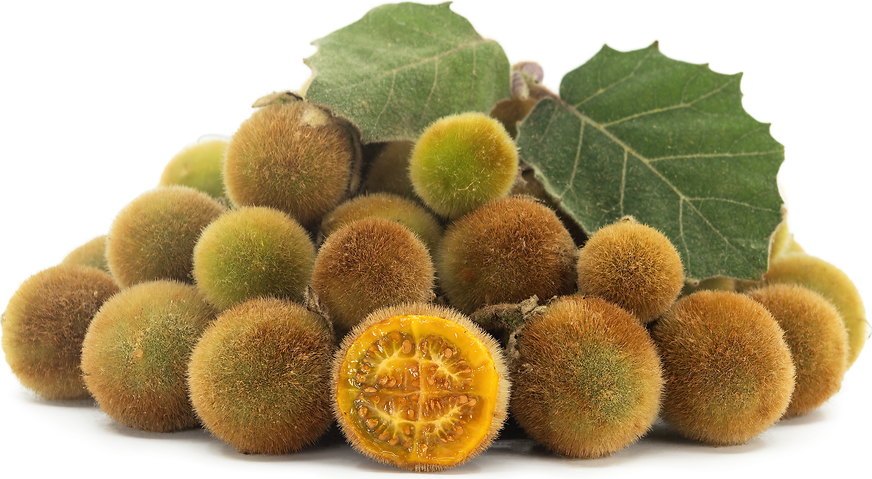


Lulo Silvestre
Estimated Inventory, lb : 0
Description/Taste
Lulo Silvestre is a small, wild fruit, averaging 5 to 6 centimeters in diameter, and has a round to ovoid shape. The fruits are smaller than the commercial lulo varieties, and the thick skin is smooth, dark orange, and taut with a leathery texture. When Lulo Silvestre is harvested from the tree, it is covered in brown, hair-like spines that can irritate the skin. The spines must be removed before consumption and should be handled with care as the fruit’s surface is also easily bruised or damaged. Underneath the skin, the flesh is divided into four sections by thin membranes and has a characteristic, translucent coloring with a green ring in the center. The flesh is gelatinous and aqueous, containing a jelly-like consistency, and is filled with many small and edible, cream-colored seeds. Lulo Silvestre has a sweet, sour, fruity, and acidic taste with tangy notes reminiscent of citrus, pineapple, and kiwi.
Seasons/Availability
Lulo Silvestre is available year-round.
Current Facts
Lulo Silvestre, botanically classified as Solarium quitoense, is a rare, subtropical to tropical fruit found on an herbaceous shrub that can grow up to 3 meters in height, belonging to the Solanaceae or nightshade family. The name Lulo Silvestre translates from Spanish to mean “Wild Lulo” and is the ancient version of the commercial lulo commonly sold in South American markets. Lulo Silvestre is not commercially cultivated and is mainly found in tropical forests, highly susceptible to pests, diseases, and climate change. Despite the plant’s delicate nature, the fruits have been used in culinary applications since the Incas and are favored as a traditional, local food source, consumed fresh or blended into drinks.
Nutritional Value
Lulo Silvestre is a source of fiber, regulating the digestive tract, provides calcium to strengthen bones, and vitamin C to boost the immune system. The fruits also contain phosphorus to assist in bone and teeth growth and lower amounts of iron, vitamins A and K, potassium, and niacin. In South American folk medicines, Lulo Silvestre is made into a tea and served as a calming drink to help reduce stress and promote better sleep. The fruits are also made into infusions to cleanse the body of unwanted toxins.
Applications
Lulo Silvestre is used as a flavoring in both raw and cooked applications. It is important to note that the fruits are sometimes covered in spine-like hairs that can be irritating to the skin if handled straight off the tree. Lulo Silvestre should be harvested with gloves, and when ripe, the surface can be brushed to remove the hairs. Once cleaned, the fruits can be sliced in half and eaten raw, consuming the flesh and small seeds, or the flesh can be scooped out and used as a fresh topping over yogurt, oatmeal, cakes, and fruit salads. Lulo Silvestre can also be cooked into jams and jellies, mixed into sauces for savory main dishes, or incorporated into pies, tarts, and other baked goods. In Colombia, Lulo Silvestre is popularly combined with banana and blended into ice cream, sorbets, shaved ice, or made into a mousse. Lulo Silvestre pairs well with cinnamon, fruits such as banana, papaya, mango, strawberry, and passionfruit, chocolate, lentils, tomatoes, and meats such as poultry, beef, and seafood. Whole, half-ripe fruits will keep up to one week when stored at room temperature away from direct sunlight. Once ripe, the fruits are highly perishable and should be consumed within 1 to 2 days.
Ethnic/Cultural Info
Lulo Silvestre has traditionally been used in Colombia to flavor sweet-tart beverages. The fruits are incorporated into many different drinks, including blended, frozen, muddled, and pureed, and depending on the beverage, the fruits can be used plain or paired with other ingredients. In the department of El Valle del Cauca in Colombia, Lulo Silvestre is incorporated into a beloved drink known as champus, which is an unusual mixture of sweet and spice-forward flavors. Champus consists of Lulo Silvestre combined with dried corn, orange zest, cloves, cinnamon, raw sugar, and pineapple. The thick drink is a favorite afternoon beverage and is commonly sold through street vendors. Lulo Silvestre is also used in lulada, a beverage made from fruits, sugar, ice, water, and lime juice. Lulada is customarily blended to form a frothy consistency and is a sweet and sour treat often sold at restaurants and hotels. Beyond champus and lulada, Colombians forage Lulo Silvestre from the wild and use the fruits to make smoothies, juices, and sorbets at home as a refreshing dessert or afternoon snack.
Geography/History
Lulo Silvestre is native to the Northwest region of South America, specifically Colombia, Peru, and Ecuador, and has been growing wild since ancient times. The brightly colored fruits are found in low mountain areas and tropical forests and were spread throughout South America and Central America in the early ages. Lulo Silvestre was first recorded by scientists in the mid-17th century and was consumed on a small scale by native peoples, favored for its sweet and sour flavor. Today Lulo Silvestre has remained localized to primarily South America and is somewhat challenging to find in comparison to the cultivated versions of the fruit. Lulo Silvestre is traditionally foraged from the wild or grown on specialty farms and sold in local markets.
Recipe Ideas
Recipes that include Lulo Silvestre. One
| Una Colombiana en California |
|
Jugo De Lulo |
| Laylita's Recipes |
|
Colada de Avena Con Lulo |
| Suellen Pineda |
|
Lulo Popsicles |




